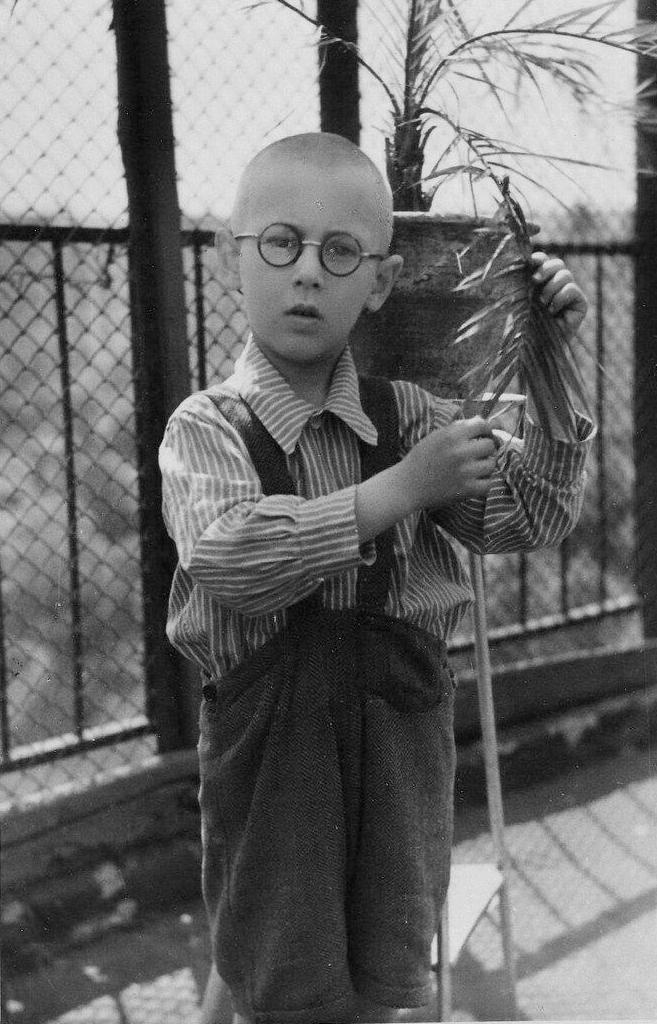
Russian Jews: Soviet Atheist Campaign (1919-45)

Figure 1.--The Soviet atheist campaign began with the Bolsheviks, but intensified under Stalin. Most Jewish boys in the Soviet Union grew up knowing nothing about Judaism and their heritage. Some did not even know they were Jews. It was dangerous to have Jewish religious items like a menora at home. We wonder if this boy's mother nutured a palm tree as a safe way to maintain a small connction with her heritage. .
|
|
Lenin publicly condemned anti-Semitism. The initial focus of the Bolshevik atheist campaign was on Christians, but Jews and Muslims were eventually argeted a well. The Bolsheviks including Jewish Bolsheviks were hostile toward Judaism from the beginning of the Soviet regime. Jews were organimg politically before the Revolution. They were active Social Democratic Labour Party from which the Bolsheviks sprung. There was a Jewish Bund to which Trotsky first belonged. It should be stressed that Russian anti-Semitism was more religious anti-Semitism, not racial anti-Semitism like the NAZI variant. Even so, historic Russian anti-Semitism was so strong that secular Jews were subject to decrimination throughout the Soviet era. Soviet officials abolished Jewish community councils (1919). These were the Jewish comminity groups traditionally responsible for maintaining synagogues. The Bolsheviks created a special Jewish unit of the Party. This unit was given the responsibilty to conduct a prpaganda campaign against the Jewish elders, clergy, and religion in general. The Hehalutz Zionist youth movemrnt was supressed (1926). [Solzhenitsyn, p. 36.] Eventually a kind of Soviet Zionist movemrnt was established. It was designed to direct Jewish national and religious aspirations in an approved Soviet direction. Stalin created the Jewish Autonomous Oblast (1928). Birobidzhan was made the capital. It was located on the Trans-Siberian Railway, near the China-Russia border. It was depicted as the Soviet Zion. Yiddish rather than Hebrew, which was described as reactionary, was to be the national language. Hebrew was supressed because of its association wu\ith Judaism. Party activists were to oversee the process of repacinh Judaism with proletarian socialist literature and arts. Soviet officials launched a massive domestic and international state propaganda campaign. A limited number of Jews decided to move there. The Jewish population there never reached 39 percent and today is mimimal. The experiment did not last long. Stalin's moved against religious Jews forcefully in the mid-1930s as part of the first major purge campaign. The NKVD began arresting Jewish leaders. Many were sumarily executed. The NKVD closed Yiddish schools. Persecutions and purges continued for several years. [Montefiore] Stalin's atheism campaign closed most of the 5,000 synagogues functioning during the Tsarist era. Supression of Jews was relaxed somewhat during the War. Basically it became impossible even dangerous to practice Judaism. The training of rabbis ended. his did not change until a limited relaxtion during the War. Until the Soviet Union began to implode, only one Yiddish periodical was published (late-1980s). Parents began to avoid pactice of Judism eb\ven in the homes. Children began growing up with out any knowledge of Judaism except descrination experienced from other Russians because of their looks and names. Some children grew up not even knowing that they were Jews.
Sources
Montefiore, Simon Sebag. Stalin: The Court of the Red Tsar (2007).
Solzhenitsyn, Alexsanddr I. Trans, Thomas P. Wjitney. The Gulag Archipelago, 1918-56: An Experiment in Literary Investigation (Harper & Row: New York, 1973), 660p.
CIH

Navigate the Children in History Website:
[Return to the Main Russian Jews page]
[Return to the Main Russian page]
[About Us]
[Introduction]
[Biographies]
[Chronology]
[Climatology]
[Clothing]
[Disease and Health]
[Economics]
[Freedom]
[Geography]
[History]
[Human Nature]
[Ideology]
[Law]
[Nationalism]
[Presidents]
[Religion]
[Royalty]
[Science]
[Social Class]
[Bibliographies]
[Contributions]
[FAQs]
[Glossaries]
[Images]
[Links]
[Registration]
[Tools]
[Children in History Home]
Navigate the Boys' Historical Clothing ethnic pages:
[Main Russian ethnic page]
[Main ethnic page]
[German]
[Greek]
[Irish]
[Native American]
[Scottish]
Created: 3:33 AM 4/20/2019
Last updated: 3:33 AM 4/20/2019



